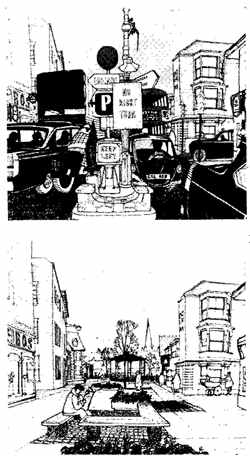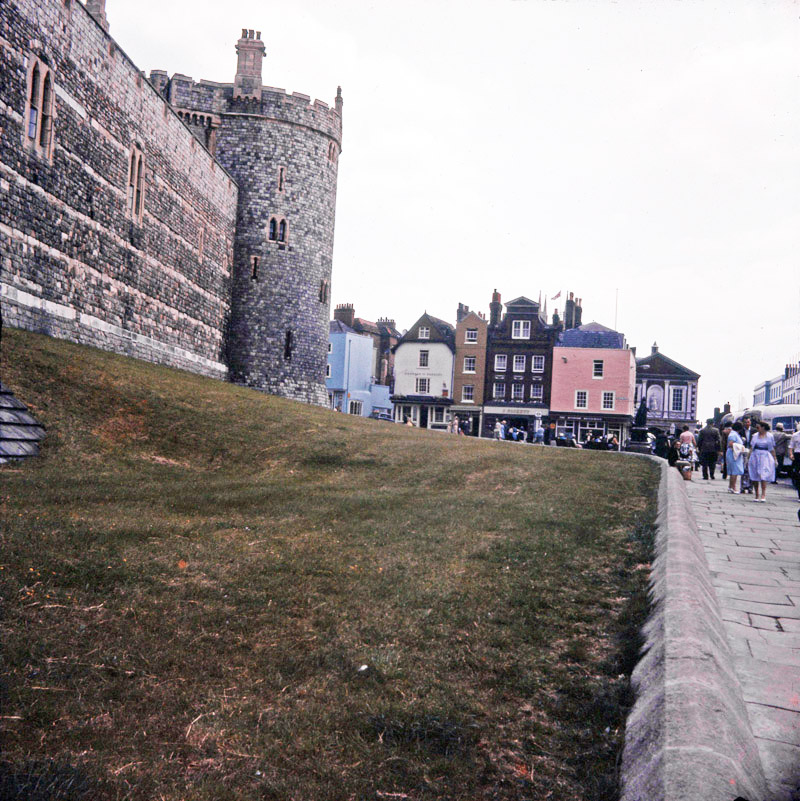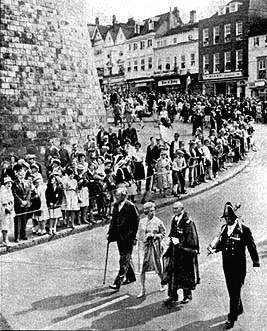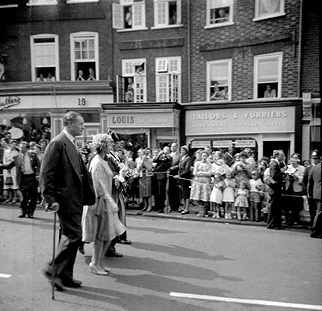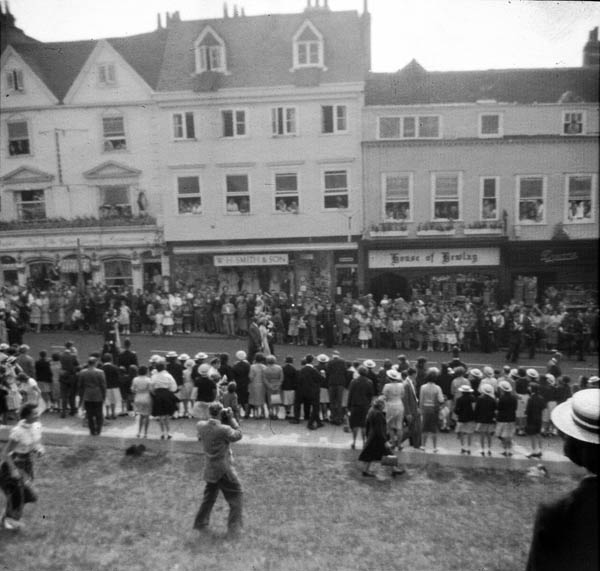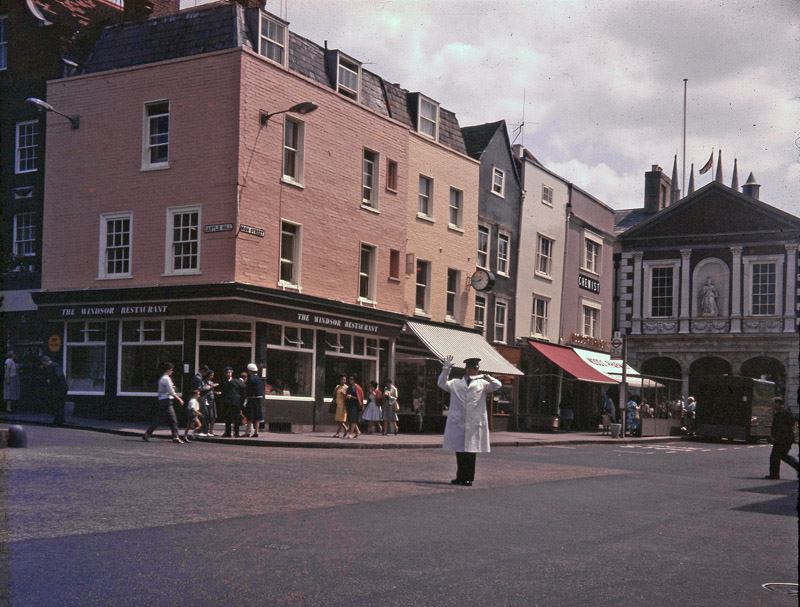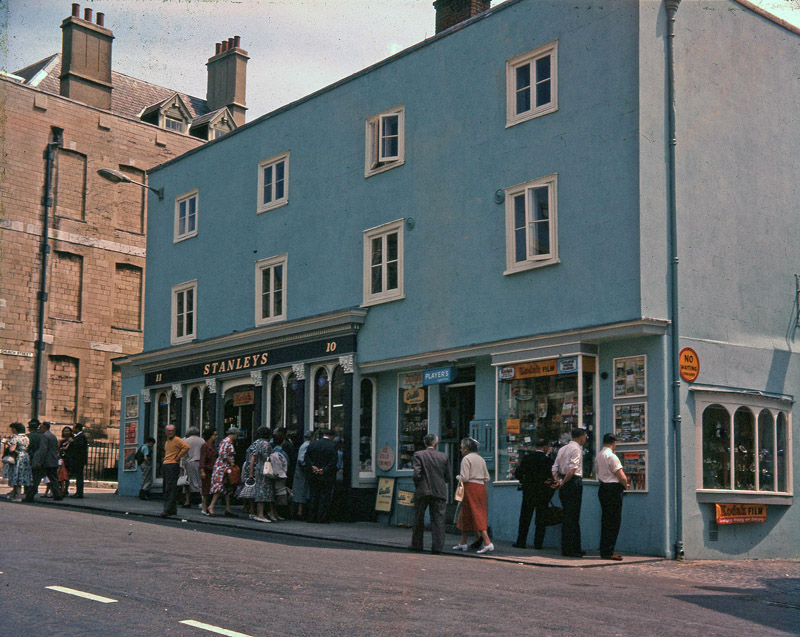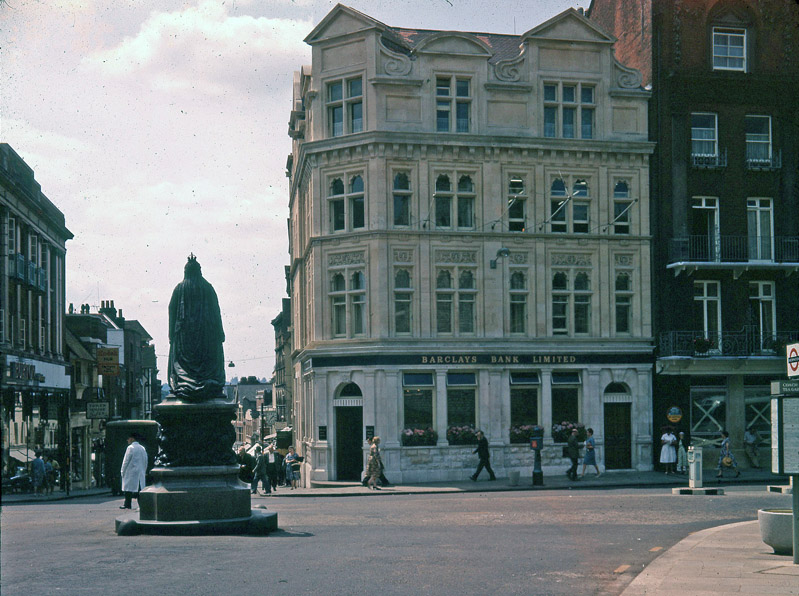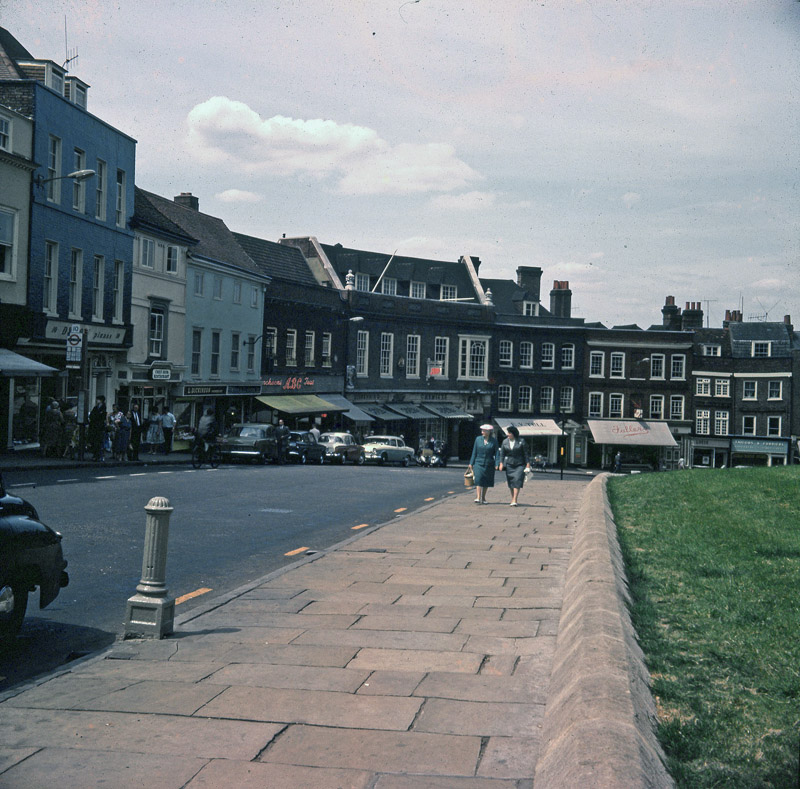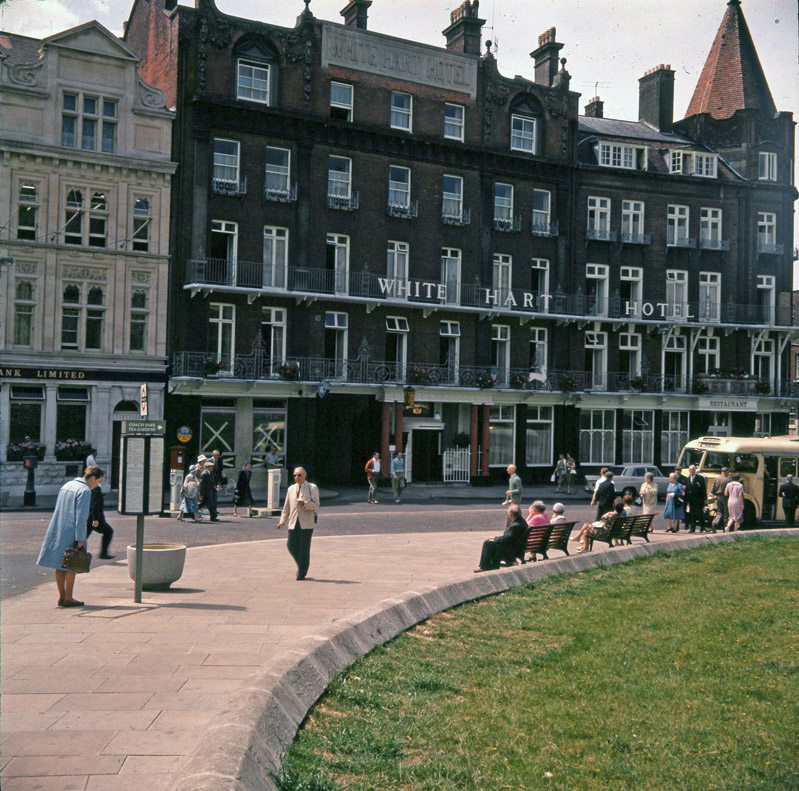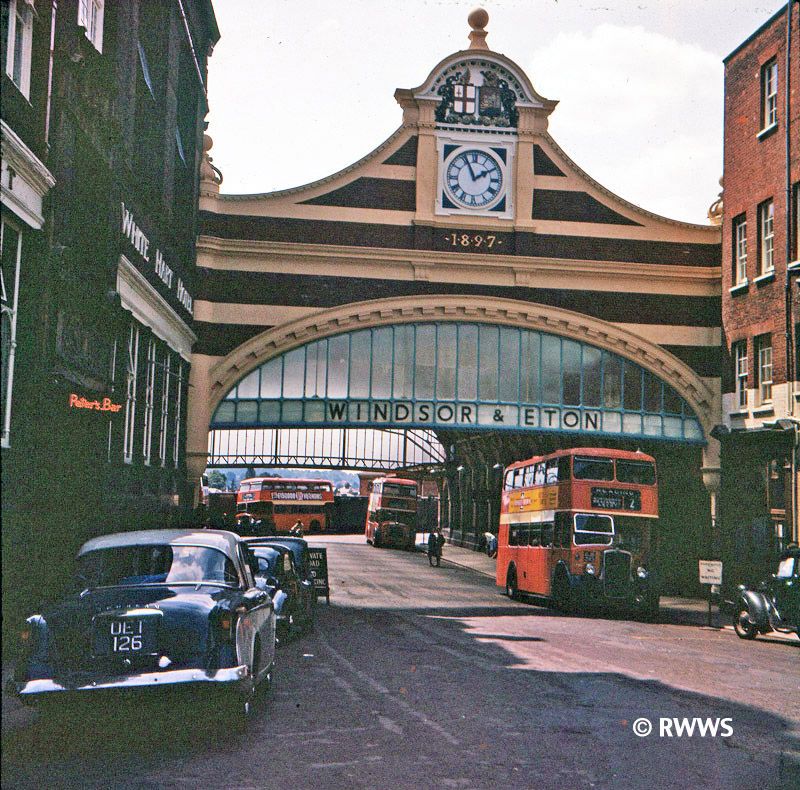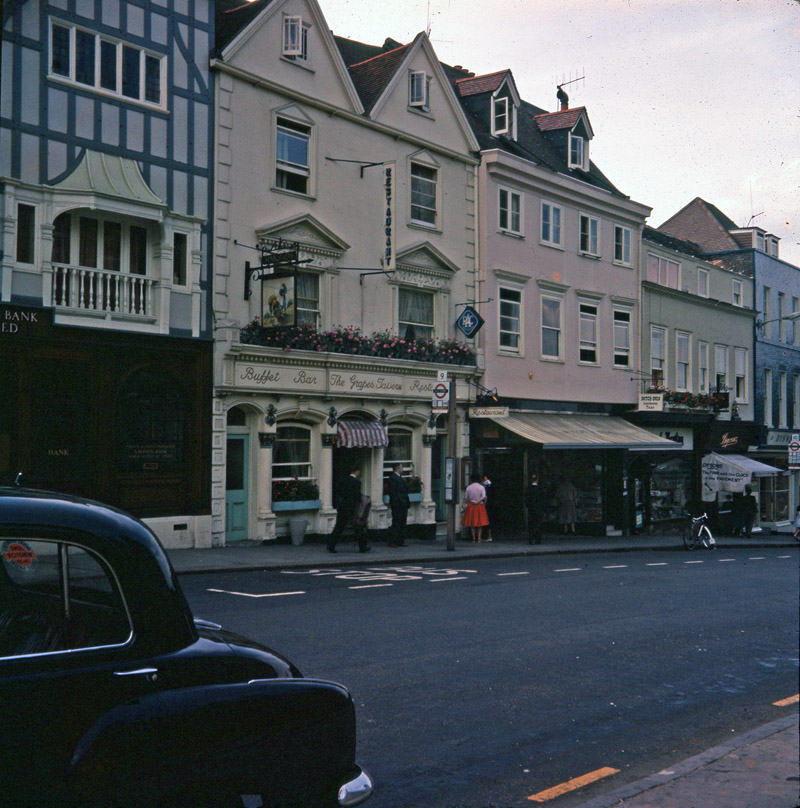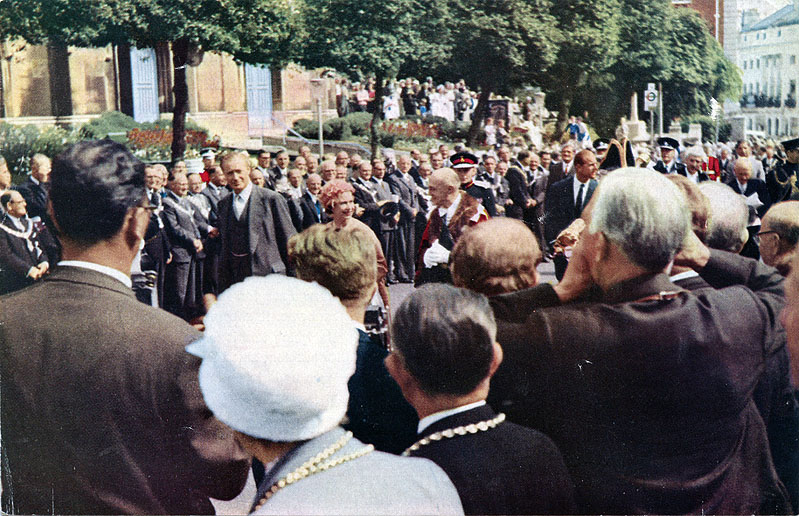This is the report that was prepared at
the time following completion of the scheme.
The previous improvement schemes initiated
by the Civic Trust, in Magdalen Street, Norwich, and Burslem,
Stoke-on-Trent, were, in a sense, exercises in rejuvenation.
The former, a Cathedral City shopping street in decline, contained
a number of fine buildings and it sprang to life afresh after
a radical spring clean. The latter, a typical legacy of the nineteenth
century industrial revolution, had quite disintegrated and required
the creation of a new heart.
The Royal Borough of Windsor, scene of the Trust's
third pilot scheme, has little in common with these. It is a
quiet but busy and prosperous town, with plenty of character;
in spite of the tens of thousands of tourists who visit it every
summer, it is clean and tidy too. Not a place, most people would
have said in need of improvement. Towns evolve in a haphazard
way, however shaped by a multiplicity of unrelated decisions:
there are few urban areas anywhere in the world, the appearance
of which has ever been subjected to overall scrutiny and design.
The architectural interest of the Windsor improvement scheme
perhaps lies in this: to what extent can an above-average street
or other urban area be improved by such an operation? What has
been done in Windsor is, inevitably, less dramatic in its effect
than the improvement effected in Magdalen Street and Burslem;
it is no less real, however, and, in its context, no less marked.
The Windsor scheme confirms the Trust in its view that there
is no area, the appearance of which cannot be improved, at relatively
small cost, if all those concerned are prepared to work together
voluntarily to that end.
Origins and Sponsorship
Officers of the Windsor Corporation attended
the opening of the Magdalen Street Scheme in 1959 and the Corporation
subsequently approached the Trust with a view to initiating a
similar project. Joint meetings were held with the Chamber of
Trade and, after it became clear that there was support for the
idea, the Trust agreed to undertake the co-ordination of a scheme.
Mr. Noel Tweddell, FRIBA, DistTP, formerly Chief Architect and
Planner of Basildon New Town, was nominated as Co-ordinating
Architect. It was decided that the scheme should embrace the
whole of Lower Thames Street, Thames Street and the High Street;
also the cluster of old properties between the Guildhall and
the Castle in Church Street, Church Lane, Market Street and Castle
Hill. In the area as a whole are some 120 properties, most of
them shops, but including hotels, banks and public houses; among
the organisations to be involved in the operation, in addition
to the Windsor Corporation, were the Ministry of Transport, the
Ministry of Works, the G.P.O., British Railways and London Transport.
What was done
The whole of this area is dominated by
the great bulk of the Castle, round the Western wall of which
High Street and Thames Street wrap themselves. The object of
the scheme was to enhance the character and dignity of this unique
relationship.
The street picture, even in Windsor, was confused
by a multiplicity of structures and objects and signs, none of
them particularly offensive in themselves but cumulatively irritating
and unsightly. There were, for example, in the area under consideration,
221 signs of one sort and another: 148 traffic signs, including
106 'No Waiting' and 'Waiting Limited' signs; 29 Corporation
and others, excluding 11 public transport signs; others included
some 33 electrical signs on buildings. All these it has proved
possible drastically to reduce, in particular by the redesign
of certain Ministry of Transport traffic signs and an extended
use of the Ministry's experimental yellow kerb line. In many
cases the new traffic signs have been affixed directly to the
buildings, thus doing away with the previous striped poles.
Bus shelters, seats and litter bins have been replaced
by others of improved design. Sand, transformer and switchgear
boxes have been removed from the pavements and resited less obtrusively.
Telephone kiosks have also been resited. A new and vastly improved
lighting scheme for the street has made possible the replacement
of 18 lighting columns and three hanging lights, by 36 lanterns
bracketed from the buildings thus noticeably improving the view
of the Castle. A number of other lanterns have been converted
or installed at particular points.
Of the 120 properties in the area, only a handful have felt unable
totally to participate, A number of buildings which where in
need of basic repair have made good their street elevations.
Those redecorating have conformed to a range of 30 colours and
wherever possible buildings in divided ownership have unified
the upper parts of their premises. A number of inappropriate
signs on buildings have been removed. The Wren-designed Guildhall
and Corn Exchange have been cleaned, the statuary repaired and
repainting has included the use of a strong Peacock Blue on the
ceiling of the Corn Exchange. The main piers at the entrance
to the Parish Church of St. John's have been. rebuilt and new
wrought iron gates have been made without charge by Mr. J. House,
the Corporation blacksmith.
Kerb lines have been changed in three places, primarily
for reasons of traffic flow, car parking and pedestrian safety,
but the opportunity has been taken at the Park Street corner
at the same time to plant trees and install flower tubs. Castle
Hill and High Street have both been resurfaced. Floodlighting
has been installed on the Guildhall, the Parish Church, the War
Memorial and King George V Memorial; Barclays Bank and The Ship
have also contributed special external lighting to their premises.
The Wall
The biggest single change in the appearance
of the High Street has been the removal, by gracious permission
of H.M. The Queen, of the boundary wall dividing the Castle from
the street. The wall was built a little over a century ago, after
the demolition of the small cottages and houses that had previously
clustered under the Castle Wall itself. Almost 500 ft. long and
6 - 12 ft. high, it blocked the view from many points but served
no useful purpose. Its removal, and the clearance of all extraneous
street furniture from the pavement it abutted, has brought the
Castle right into the town and opened up a most imposing vista.
In the autumn two forest trees will be planted near the Salisbury
Tower.
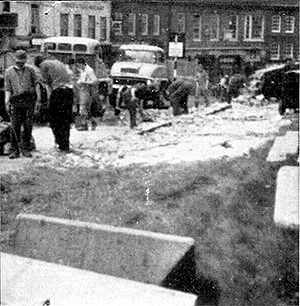
Work proceeds apace on the demolition
of the wall between the High St and The Castle
The work was carried out by the Ministry
of Works, who removed the coping and reset it at pavement level,
and by a team of volunteers, organised by the Civic Trust with
equipment and other assistance kindly loaned by Messrs. Wimpey.
The Trust has for some years organised work camps for the demolition
of large-scale eyesores in National Parks and rural areas. It
has recently applied the principle to a pilot urban scheme in
Stepney and Windsor provided another example of the contribution
that can be made to the appearance of our towns by public spirited
volunteers. Mr. Duncan Sandys himself knocked out the first stone
just before Easter. The team which the took over consisted of
twelve students from different parts of the country who camped
in a local school, worked for a fortnight in rain and sun and
finished their task a day ahead of schedule.
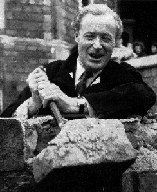 |
The Rt. Hon. Duncan Sandys
attacks the wall as part of a publicity exercise.
|
Conclusion
It must be remembered that in schemes of
this kind, streets and buildings are not redesigned ab initio;
that neither the Local Authority, nor the Chamber of Trade, nor
the Civic Trust have any powers other than the power of persuasion.
The extent to which any particular proposals may actually be
implemented depends upon individual taste, individual readiness
to meet the cost involved, individual trading problems and competition,
individual house-styles and redecoration programmes, together
with a multiplicity of factors, often conflicting, created by
public utilities and public accounting.
There remain things in Windsor, between the river
and Park Street which the Civic Trust would have been glad to
change but which, usually on grounds of cost, could not be undertaken
on this occasion. There may be instanced, as an example, the
King George V Memorial at the corner of Datchet Road: designed
for a site that was originally bounded by buildings in Datchet
Road: this now sits, since the demolition of the buildings, uneasily
upon an axis that no longer relates to the area. The statue of
Queen Victoria, at the foot of Castle Hill, might with advantage,
it may be thought, be moved either to the grassy embankment surrounding
the Salisbury Tower, or to the new paving at Park Street corner
where, among the newly planted trees, it could form a welcome
focal point. One day, too, it may prove possible to resolve the
somewhat indeterminate relationship of the Curfew Tower to the
pavement of which it forms the hub, possibly by the construction
of a small terrace with seats where shoppers could rest their
feet and visitors admire the view.
Such things, however, can still be done in the future.
Schemes of this kind are not finite. Towns continue to change
and develop and improvements to a town's appearance do not cease
to become necessary or possible after an arbitrarily chosen date.
What must have struck any visitor to Windsor during April 1961
was the astonishing sense of corporate endeavour shown by the
activity in the High Street and Thames Street. In all directions,
scaffolding, building material and ladders were to be seen; men
were painting, drilling, laying paving, installing lights or
bus shelters. When a town shows its passionate concern with,
and pride in, its appearance in this way, things are unlikely
ever to be quite the same again.
May 1961
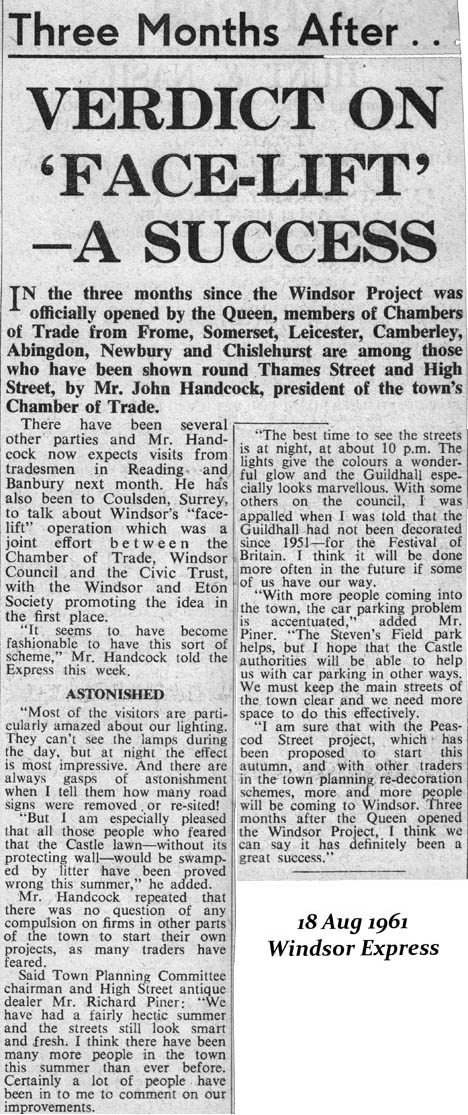
|
A film, New Face for Britain:
A Make-over for Windsor was made by the Civic Trust at the
time and copies are now to hand.
Please email Thamesweb
for more information and rental charges.
|
Back
to Histories Home Page
Back
to Windsor Home Page
All photographs are © The Royal
Windsor Website.

To contact
us, email Thamesweb.
|
